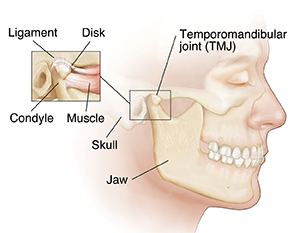When You Have Temporomandibular Disorder (TMD)
The temporomandibular joint (TMJ) is a ball-and-socket joint located where the upper and lower jaws meet. The TMJ and its nearby jaw muscles make up a complex, loosely connected system. Because of this, a problem in one part of the system can affect the other parts. This can cause you to have temporomandibular disorder (TMD).
How the temporomandibular joint works
You have one joint on each side of your mouth that together make up the TMJ. These joints are part of a large group of muscles, ligaments, and bones that work together as a system. When the system is healthy, you can talk, chew, and even yawn in comfort. Muscles contract and relax to open and close the joint. The disk is made of cartilage and is located between the condyle and the skull. It absorbs pressure in the joint and allows the jaws to open and close smoothly. Fluid (called synovial fluid) lubricates the joints. Ligaments connect the lower jaw bones to the skull. They also support the joint.

Common temporomandibular problems
When there is a problem with the TMJ and its related system, you can develop TMD. Common TMD problems include tight muscles, inflamed joints, and damaged joints.
In some cases, symptoms may be related to the teeth or bite.
Tight muscles
The muscles surrounding the TMJ can tighten (spasm) and cause pain.
-
Referred pain. This happens in a part of the body separate from the source of the problem. For example, pain in the face or teeth could be coming from a problem in the TMJ.
-
Myofascial pain. This happens in soft tissues, such as muscle. Trigger points in these pain areas often cause referred pain. You may feel jaw, neck, or shoulder pain.
Inflamed joints
Inflammation may include pain, redness, heat, swelling, or loss of function.
-
Synovitis. This happens when certain tissues around the TMJ become inflamed. It causes pain that increases with jaw movement.
-
Inflamed ligaments. This can be caused by strain or injury. When this happens, the ligaments are unable to support the joint.
-
Rheumatoid arthritis. This is an autoimmune joint disease. It leads to inflammation and pain in the TMJ.
Damaged joints
Many people hear clicking when their jaw moves. If you feel pain along with the noise, the joint may be damaged.
-
Impingement. This happens when the disk slips out of place (displacement). This causes the jaw to catch. As the disk slips, you may hear a clicking sound.
-
Locked jaw. This happens when the disk gets stuck in one position. As a result, the jaw locks open or closed.
-
Osteoarthritis. This is a joint disease. It causes the TMJ to wear away (degenerate). This leads to pain during movement.
Other problems
The parts of the jaw and mouth make up a single unit. That’s why a problem in 1 area can cause symptoms elsewhere. Teeth or bite problems linked to TMD include:
-
Grinding your teeth side to side (bruxism)
-
Biting down on your teeth (clenching)
-
When the teeth or bite is out of alignment (malocclusion)
Your healthcare provider will give you more information about these problems if needed.